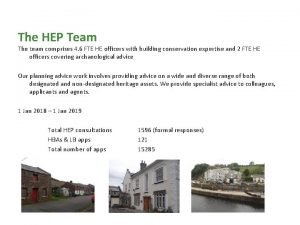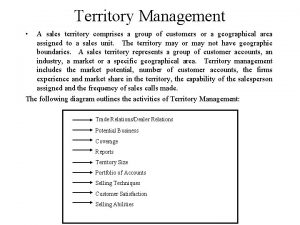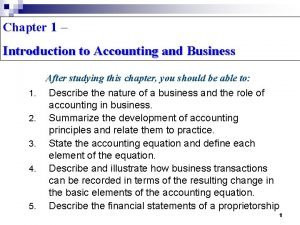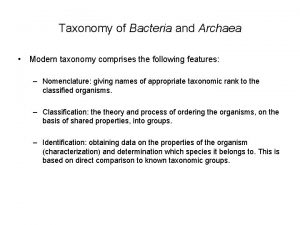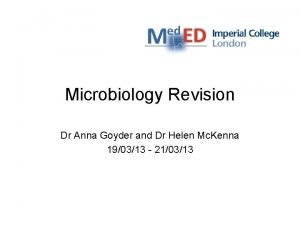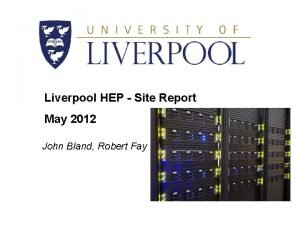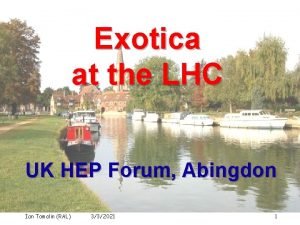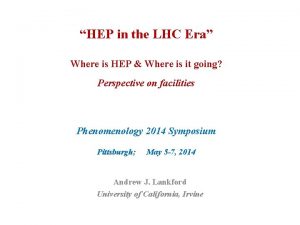The HEP Team The team comprises 4 6














































- Slides: 46

The HEP Team The team comprises 4. 6 FTE HE officers with building conservation expertise and 2 FTE HE officers covering archaeological advice Our planning advice work involves providing advice on a wide and diverse range of both designated and non-designated heritage assets. We provide specialist advice to colleagues, applicants and agents. 1 Jan 2018 – 1 Jan 2019 Total HEP consultations HBAs & LB apps Total number of apps 1596 (formal responses) 121 15285

Development Management Area Planning Teams (April 2019) Although not a hard and fast rule for the Historic Environment Planning (HEP) team, in general terms, we currently cover the areas as follows: Area 1 - Nina Paternoster (SDO) nina. paternoster@cornwall. gov. uk 01872 224315/07973 813556 Area 2 & 3 - Colin Buck (SDO) colin. buck@cornwall. gov. uk 01208 262841/07968 892144 Area 4 - Georgina Murray (DO) georgina. murray@cornwall. gov. uk 01872 324798 Area 5 - Louise Whitby (DO)(secondment) louise. whitby@cornwall. gov. uk 01208 265608/07889 654266 Area 6 & 7 - Vic Robinson (SDO) vic. robinson@cornwall. gov. uk 01726 223454/07484 908922 Area 8 - Kate Loubser (DO) kate. loubser@cornwall. gov. uk 07483 147946 Archaeology - Phil Copleston (SDO) phil. copleston@cornwall. gov. uk 01579 341406/07973 813571 Although currently away, we also have Tammy White whose details are: Tammy White (SDO), tammy. white@cornwall. gov. uk , 01208 265714

How we assess proposals • Understand significance • Check designations, historic maps, HER, HS/HIA – information requirements. • Impacts on historic fabric, planform, character and architectural features, design of new additions, junctions between old and new, use of materials and detailing. • Impacts on character and appearance – scale, massing, design, layout, landscaping, use of materials - local distinctiveness. • Impacts on the setting of designated and non-designated heritage assets. HE Legislative and policy Framework • Planning (LB and CA) Act 1990 • NPPF parts 12 and 16 and planning practice guide • Cornwall Local Plan Policy 24 • Historic England Guidance Making Changes to Heritage Assets – Historic England Advice note 2 The Setting of Heritage assets – Historic England Advice note 3 » Conservation Area Appraisals and Management Plans

How Local Councils can help Highlight information gaps e. g. Heritage Statements and Impact Assessments Make comments on applications affecting the Historic Environment Request planning case officers consult with HEP for advice if we haven’t been consulted Report unauthorised works affecting the HE to enforcement

The Strategic Historic Environment Team The team is as follows: • Team Leader Pete Herring – Heritage Strategy and Cornish Distinctiveness • Francis Shepherd & Hannah Curnow - Historic Environment Record Team • Nick Cahill & Andy Richards – Strategic Historic Environment Officers (broadly split between Policy/strategic advice and Regeneration and practical guidance) • Ann Reynolds – Countryside historic environment/agrienvironment advice • Martin Searle – Project Officer St Austell TH Scheme • Lauren Hatt – Apprentice.

Significance…or…why does this place matter? Nick Cahill, Historic Environment Strategy Officer, Environmental Growth and Partnerships

THE HISTORIC ENVIRONMENT IS ONE OF THE KEY FACTORS THAT MAKES CORNWALL AN ATTRACTIVE PLACE TO LIVE, WORK AND VISIT


HERITAGE ASSETS ARE NON RENEWABLE AND UNDER THREAT…. increasingly obvious issue for us here in Cornwall connected to both development and climate change

WITH INTELLIGENTLY MANAGED CHANGE HERITAGE ASSETS CAN BE A CATALYST FOR REGENERATION, AND CREATION OF DISTINCITVE PLACES.


The purpose of this workshop How you can help our understanding of, and influence the future of, the historic environment of Cornwall. . . …which means. . .

Knowing what to look for when thinking about the historic environment… …which means. . .

Thinking about heritage values and significance… …and what, exactly, do we mean by significance, and why is it so important?

FIRST TWO QUESTIONS FOR THIS EVENING… What are the most important places in Cornwall to you? Why are they important to you?



What are the most important places in Cornwall to you? Why are they important to you? Are they actually ‘heritage’ sites? Are we thinking about the historic environment and planning policy?

Heritage assets should be conserved “in a manner appropriate to their significance, so that they can be enjoyed for their contribution to the quality of life of existing and future generations” – nppf 184

So what is significance? Significance (for heritage policy): The value of a heritage asset to this and future generations because of its heritage interest. That interest may be archaeological, architectural, artistic or historic. Significance derives not only from a heritage asset’s physical presence, but also from its setting.





STAGE 1 – INDENTIFY THE SITE …a building …. a place…. . landscape (man made or ‘natural’ – is there any such thing in Cornwall? ) or street or village centre… …the site of something…’archaeology’

STAGE 2 – EXPLAIN SIGNIFICANCE 1. Briefly outline the known heritage significance and 2. explain any significance you’ve discovered through analysing the site.

TYPES OF HERITAGE INTEREST: ARCHAEOLOGICAL The potential a place has to yield new evidence from expert study about the substance and evolution of places, and of the people and cultures that made them

ARCHITECTURAL (AND/OR DESIGN) The intrinsic design and aesthetic qualities of buildings, structures and landscapes.

ARTISTIC The direct product of the artist’s or craftworker’s hand Often very difficult to distinguish from architectural and/or design interest – in practice it may be difficult, and perhaps not necessary even to attempt a distinction.

HISTORIC The way the site, building or place can illustrate, or be directly associated with historic events and past lives.

Other things to think about: Evidence/authenticity: evidence for actual or potential interest needs to be compelling, well authenticated, any changes explained (they won’t necessary diminish the interest of the asset). Age: aesthetic, architectural or artistic values on their own don’t give heritage interest – there has to be some measure of distance in time or cultural reference

Integrity/survival: substantial and/or recognisable form and direct experience of historic fabric or landscape strengthens value Cornish Cultural Distinctiveness: does the site embody or physically express, perhaps even by its mere presence, a significant characteristic or narrative important to Cornish culture and cultural distinctiveness?

Local v. national significance: a sense of place created by locally distinctive features, or, in contrast (or, perhaps, as well), because they are of wider interest. Rarity v. representativeness: Heritage interest can arise because an asset is either rare or representative – one does not trump the other in value or interest.

Natural features and open countryside can also be considered to be heritage assets, but must demonstrate a clear and noteworthy interaction with or intervention by humanity: what is significant here is the historic interest and cultural value of the place, not simply its scenic beauty or natural environment interest, important as that may be









Cornwall Industrial Settlements reports



 Team comprises of
Team comprises of Css comprises of style rules that are interpreted
Css comprises of style rules that are interpreted Define farm management
Define farm management Territory management meaning
Territory management meaning Comprises 70% of business entities in the united states
Comprises 70% of business entities in the united states Happiness sadness anger fear disgust surprise
Happiness sadness anger fear disgust surprise Archaea
Archaea Similarities between primary and secondary succession
Similarities between primary and secondary succession Dr abhishek chowdhury
Dr abhishek chowdhury Hep b vaccines
Hep b vaccines Hepatitis b vaccine schedule for adults
Hepatitis b vaccine schedule for adults Hep international
Hep international Nucloplasm
Nucloplasm Hep c symptoms female
Hep c symptoms female Chronic hepatitis
Chronic hepatitis Hep obnovljivi izvori energije
Hep obnovljivi izvori energije Helen mc
Helen mc Hep
Hep Hep c results interpretation
Hep c results interpretation Hep b vaccines
Hep b vaccines Dalmatur
Dalmatur Liverpool hep c
Liverpool hep c Uk hep forum
Uk hep forum Hcv symptoms female
Hcv symptoms female Bureaucratic bypass syndrome
Bureaucratic bypass syndrome Team spirit becomes team infatuation
Team spirit becomes team infatuation The white team cheers for the blue team, just like
The white team cheers for the blue team, just like Diễn thế sinh thái là
Diễn thế sinh thái là Tư thế ngồi viết
Tư thế ngồi viết Giọng cùng tên là
Giọng cùng tên là Phép trừ bù
Phép trừ bù Hát lên người ơi
Hát lên người ơi Sự nuôi và dạy con của hổ
Sự nuôi và dạy con của hổ đại từ thay thế
đại từ thay thế Quá trình desamine hóa có thể tạo ra
Quá trình desamine hóa có thể tạo ra Vẽ hình chiếu vuông góc của vật thể sau
Vẽ hình chiếu vuông góc của vật thể sau Công thức tính thế năng
Công thức tính thế năng Hát kết hợp bộ gõ cơ thể
Hát kết hợp bộ gõ cơ thể Tỉ lệ cơ thể trẻ em
Tỉ lệ cơ thể trẻ em Thế nào là mạng điện lắp đặt kiểu nổi
Thế nào là mạng điện lắp đặt kiểu nổi Dot
Dot Lời thề hippocrates
Lời thề hippocrates Vẽ hình chiếu đứng bằng cạnh của vật thể
Vẽ hình chiếu đứng bằng cạnh của vật thể độ dài liên kết
độ dài liên kết Các môn thể thao bắt đầu bằng tiếng chạy
Các môn thể thao bắt đầu bằng tiếng chạy Khi nào hổ mẹ dạy hổ con săn mồi
Khi nào hổ mẹ dạy hổ con săn mồi điện thế nghỉ
điện thế nghỉ
